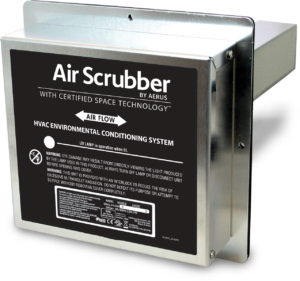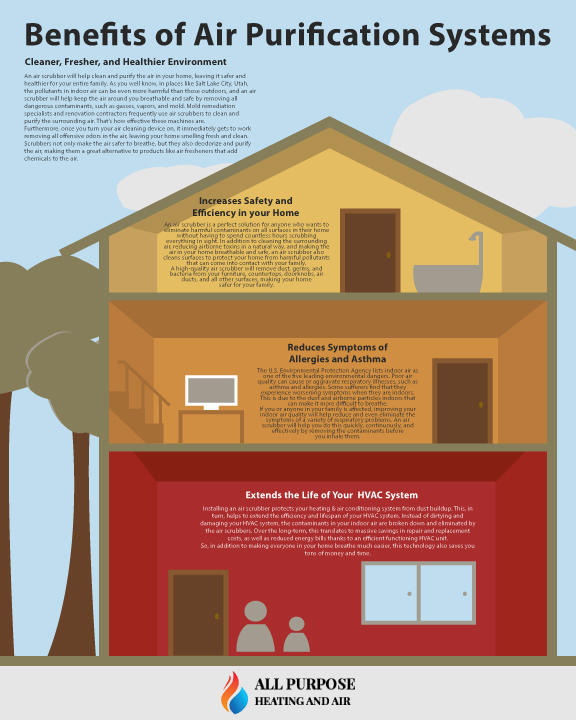
Indoor air quality, or IAQ, refers to the quality of air in and around a building or structure as it relates to the comfort and health of the people and animals occupying it. When most people think of air pollution, the first images in their minds are often massive factories pumping out dark and smelly clouds of smoke or old cars coughing out black exhaust. But the truth is, pollutants in indoor air can prove even more dangerous than pollution outside!
While there is very little any one person can do to control the quality of the air outside, the good news is that we have the power to improve the indoor air quality in our homes. In this article, we take a look at some of the most effective ways to clean the air in your home so you can start to reap the health benefits immediately.
Why Is Indoor air quality important?
It’s important to understand and control indoor air pollutants because some of them can cause serious health concerns. Examples of these include biological and chemical pollutants, such as mold or carbon dioxide. These can cause severe respiratory issues like allergies and asthma. The possibility of anyone reacting to indoor air pollutants depends on a variety of factors, including their age, preexisting medical conditions, and level of sensitivity to the particular contaminants.
There is also a likelihood of becoming sensitized with repeated or high-level exposure to harmful contaminants in the air. Soon after exposure, some people may experience irritation of the nose, throat, eyes, and nose. Others with more sensitivity may experience headaches, fatigue, or dizziness. These symptoms are usually short-term and easily treatable, particularly if the source of the pollution is eliminated. However, repeated exposure to air contaminants can cause aggravation of respiratory diseases like asthma, as well as create new symptoms that can be debilitating and even fatal.
Some effects may be worsened by the heating & air conditioning, and humidity conditions indoors. Depending on the level and duration of exposure, the health effects from such contaminants may be experienced immediately after exposure or possibly months and even years later. There are some effective ways of improving air quality to make things better for your family, such as using air scrubbers to remove all toxins from your breathing air. Improving the quality of air in your home will help you avoid the short and long-term effects of exposure to harmful air pollutants even if the symptoms aren’t noticeable yet.
What Causes Indoor Air Quality Problems?
The primary cause of issues with air quality indoors is pollution sources that release gasses or harmful particles into the air. For instance, when appliances like gas stoves and furnaces malfunction or aren’t properly vented, they can release dangerous levels of air pollutants indoors. Outside air also carries pollutants indoors, and if you live in an area like Northern Utah, you will undoubtedly have experienced most of the outdoor pollution sources.
If there is inadequate ventilation, indoor pollutant levels increase since there isn’t enough air coming in from the outside to dilute the emissions, and not enough indoor air pollutants being carried out of the building. Also, some concentrations of air contaminants are increased in areas with high temperatures and humidity levels.
Here is a list of some of the more common sources of indoor air pollutants:
- Smoking
- Carbon monoxide caused by burning fossil fuel
- Excess moisture
- Heating & air conditioning systems
- Humidification Devices
- Certain building materials like insulation that contains asbestos
- Newly installed flooring, upholstery, or carpeting
- Furniture made from pressed wood products
- Household cleaning products using harsh chemicals
- Outdoor sources like radon and pesticides
As you can see, there is a long list of sources of air pollutants from both indoors and outdoors. Some sources, like furnishings or building materials, release pollutants continuously while others, like smoking or cleaning, release pollutants intermittently. The relative importance of each source is dependant on the amount of pollutants it emits into your home, as well as how hazardous the emissions are.
How to Improve Air Quality in Your Home
Depending on the source of contaminants, there are several ways to improve the quality of air inside your home, some of which are easier and more effective than others. For instance, in the case of Radon pollution, you could eliminate the source of the pollution by screening your home to check for elevated levels using a special Radon screening kit that can be purchased online. Alternatively, you could have a qualified professional test your home in Northern Utah.
It’s also important to get your heating & air conditioning system checked professionally every year and to ensure that your heaters and other combustion appliances are installed correctly with adequate ventilation. In addition to working to eliminate the sources of air pollution in your home, one of the most effective ways you can protect your family from immediate exposure is by using an air scrubber.
What is an Air Scrubber and How does it Work?
An air scrubber is a filtration system that works to remove gasses, particles, chemicals, and biological pollutants from the air in a given area. It’s one of the absolute best ways to remove air pollution, surface contaminants, and odors in your home. It can be installed directly to the ductwork of your existing HVAC system for use as a permanent fixture. Whenever you turn on your furnace, air conditioner, or fan, the scrubbers immediately get to work using innovative air scrubbing technology to remove all toxins and irritants from the air and surfaces in your home.
This portable machine draws air from outside or the surrounding environment and passes it through filters to eliminate contaminants. An air scrubber such as the one from Aerus has technology that produces scrubber ions to remove dust and other particles from the air through the use of a catalytic process involving light waves. The majority of particles found in the home are positive ions, and by using ions that are negatively charged, an air scrubber attracts all the unwanted contaminants, removing them from the air you breathe.
Some air scrubbers are ozone-free while others come with ozone technology that increases the device’s ability to combat pungent odors from pets, smoke, cooking, and household products. Air scrubbers have been proven effective in a wide range of studies on different contaminants both on surfaces and in the air. They protect the air and purify it continuously, at the same time removing contaminants from all your household surfaces.

Air Filter vs. Air Purifier vs. Air Scrubber
Which one is right for you?
It’s important to note that an air scrubber is different from an air filter and air purifier. An air filter works to capture larger contaminants in the air, such as dust, dirt, soot particles, and so on. It’s not very effective when it comes to removing things like biological or chemical contaminants in the air, or even pet dander (tiny and sometimes microscopic skin flecks shed by dogs, cats, birds, rodents, and other animals with feathers or fur.)
An air purifier cleans airborne particles and sanitizes or purifies the air through a variety of means, such as the use of ozone, heat, or UV/UVC lamps. However, many air purifiers don’t address the issue of negative ions.
Air scrubbers, on the other hand, not only clean the air, but they also remove harmful contaminants from all the surfaces in your home. These devices actively clean indoor air by releasing positively charged ‘air scrubbers’ that reduce and eliminate pollutants in the air, including VOCs (volatile organic compounds), 99.99% of surface mold, odors, pet dander, indoor particulate matter, and much more.
Using an air Purification system in your home comes with a host of benefits:
- Cleaner, Fresher, and Healthier Environment
An air scrubber will help clean and purify the air in your home, leaving it safer and healthier for your entire family. As you well know, in places like Northern Utah, the pollutants in indoor air can be even more harmful than those outdoors, and an air scrubber will help keep the air around you breathable and safe by removing all dangerous contaminants, such as gasses, vapors, and mold. Mold remediation specialists and renovation contractors frequently use air scrubbers to clean and purify the surrounding air. That’s how effective these machines are.Furthermore, once you turn your air cleaning device on, it immediately gets to work removing all offensive odors in the air, leaving your home smelling fresh and clean. Scrubbers not only make the air safer to breathe, but they also deodorize and purify the air, making them a great alternative to products like air fresheners that add chemicals to the air.
- Increases Safety and Efficiency in your Home
An air scrubber is a perfect solution for anyone who wants to eliminate harmful contaminants on all surfaces in their home without having to spend countless hours scrubbing everything in sight. In addition to cleaning the surrounding air, reducing airborne toxins in a natural way, and making the air in your home breathable and safe, an air scrubber also cleans surfaces to protect your home from harmful pollutants that can come into contact with your family.A high-quality air scrubber will remove dust, germs, and bacteria from your furniture, countertops, doorknobs, air ducts, and all other surfaces, making your home safer for your family.
- Reduces Symptoms of Allergies and Asthma
The U.S. Environmental Protection Agency lists indoor air as one of the five leading environmental dangers. Poor air quality can cause or aggravate respiratory illnesses, such as asthma and allergies. Some sufferers find that they experience worsening symptoms when they are indoors. This is due to the dust and airborne particles indoors that can make it more difficult to breathe.If you or anyone in your family is affected, improving your indoor air quality will help reduce and even eliminate the symptoms of a variety of respiratory problems. An air scrubber will help you do this quickly, continuously, and effectively by removing the contaminants before you inhale them.
- Extends the Life of Your HVAC System
Installing an air scrubber protects your heating & air conditioning system from dust buildup. This, in turn, helps to extend the efficiency and lifespan of your HVAC system. Instead of dirtying and damaging your HVAC system, the contaminants in your indoor air are broken down and eliminated by the air scrubbers. Over the long-term, this translates to massive savings in repair and replacement costs, as well as reduced energy bills thanks to an efficient functioning HVAC unit. So, in addition to making everyone in your home breathe much easier, this technology also saves you tons of money and time.
Quick Summary Of AirScrubber Benefits
- Destroys germs and bacteria in the air and on surfaces
- Eliminates harmful air contaminants, including moisture and mold
- Gets rid of dust, pet dander, and other particles in the air
- Removes odors, purifies and freshens the air in your home
- Reduces symptoms of respiratory health conditions like allergies and asthma
- Protects your HVAC system from dust buildup
There are so many air pollutants to deal with these days. Some concentrations of air contaminants can remain in your home for very long periods and it’s important to have a safe and convenient means of dealing with them. A high-quality air scrubber will help you protect your home and keep your family safe from harmful contaminants. From asbestos, lead, formaldehyde/pressed wood, and other building materials to carbon monoxide, radon, pesticides, and indoor particulate matter, you will have the peace of mind of knowing that these pollutants are constantly being removed from the air you breathe inside your home.
If you are in Northern Utah, contact All Purpose Heating and Air right now to discover how we can help you improve the quality of air in your home with high-quality Air Scrubbers by Aerus! Our team is on hand to provide additional information and answer any questions you may have.

